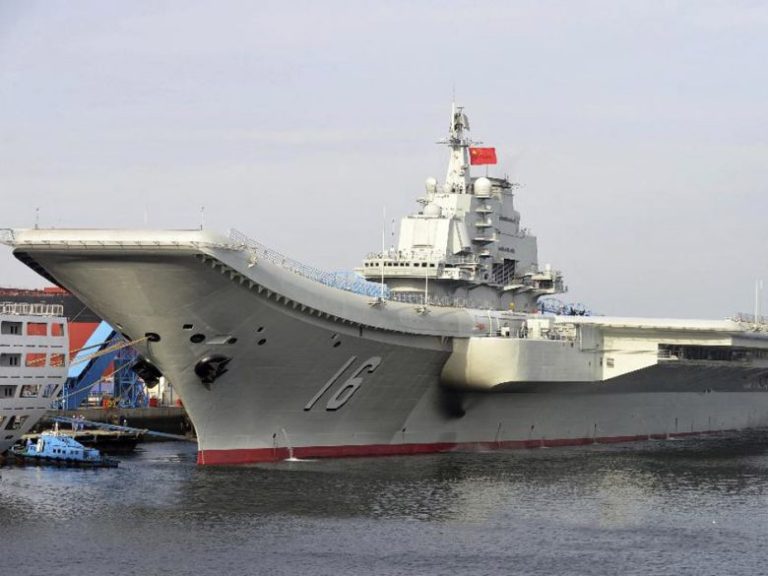Since the beginning of the 21st century, the Chinese People’s Liberation Army has been pouring hundreds of billions of dollars each year into upgrading and expanding its forces. In the last few years, China has launched two aircraft carriers and has a third on the way. The communist state is also spending a fortune on spaceflight, and became the first country to land a probe on the far side of the Moon.
The PLA has long relied on Russia for military imports, while buying or stealing Western technology in recent decades. But some of its most impressive new possessions came neither from negotiations with the Kremlin, nor by taking advantage of China’s privileged trade status with democracies like the United States. Instead, China has found an eager supplier in the former Soviet republic of Ukraine.
In 1991, the Soviet Union collapsed, leaving behind a vast arsenal of advanced weapons, massive industrial complexes, and skilled researchers. Russia, being the biggest member and center of the former superpower, inherited most — but not all — of the Soviet Union’s military strength.
From Soviet to Ukrainian to Chinese
With the end of the Soviet Union, Russia’s southwestern neighbor, Ukraine, received ownership of unique capabilities it could never have needed or wanted to develop on its own. The Ukrainian Soviet Socialist Republic was home to the developers of Soviet space rockets and nuclear missiles, as well as the latest ships and naval centers.
Success
You are now signed up for our newsletter
Success
Check your email to complete sign up
Both the rockets and the ships are now being sold to China, and even many of the engineers who built them have been recruited by Chinese companies serving the PLA.
In the last years of the Cold War, the Soviet Union tried to match the U.S. Navy by building aircraft carriers. One of these was the half-finished Riga, renamed Varyag just a year before the Soviet Union collapsed. Because Varyag was in Ukrainian territory, it became a Ukrainian ship, rusting away because there was no need for it, much less funding to complete its construction and outfitting.
As the countries of the former Soviet Union suffered political and economic hard times, China grew richer and more powerful. In 1999, a Hong Kong company bought Varyag for just US$20 million, a massive bargain considering the resources that went into the Soviet carrier program. Even though the sale attracted attention, it came with a promise from the buyer: Varyag would become a floating casino, not a military vessel.
That promise was broken in 2005, when Varyag was towed from Hong Kong to Dalian, a major military port in Northeast China. Conveniently, Varyag came with 20 tons’ worth of technical documents representing 30 years of Soviet experiences in building aircraft carriers, as reported by the South China Morning Post. Named for Liaoning Province, where Dalian is located, the ship was launched in 2012 as Type 001 Liaoning.

The Type 001 Liaoning under maintenance. (Image: CEphoto, Uwe Aranas)
Liaoning was followed up by an improved version, the Type 001A, which was completed much faster and launched in 2017. A third aircraft carrier, Type 002, is being built.
Exporting tech and experts
Ukraine’s aid to Chinese carrier projects goes beyond the initial sale of Varyag. China acquired a prototype Soviet jet fighter, the Su-33, from a Ukrainian supplier, and reverse-engineered it to create the J-15, which the PLA Navy now uses on its carriers. In addition, according to The Epoch Times, key Ukrainian shipbuilding experts were hired by Chinese companies to help its naval development. One is the 78-year-old Valery Babich, who took part in the design and construction of all Soviet aircraft carrier projects.
Apart from naval technology, Ukraine also inherited much of the Soviet Union’s missile and space industry, and the Ukrainian government is deepening ties with Beijing in this field.

A 2011 Ukrainian postage stamp bearing the image of Mikhail Yangel, the Soviet rocket engineer who headed the OKB-586 design bureau. (Image: Public Domain)
On Jan. 18, Ukraine’s Channel 24 reported on cooperation between China and Ukrainian state-owned designer of satellites and rockets, the Yuzhnoye State Design Office. The report noted that U.S. officials expressed concern about the possibility of China landing “on the Moon with the help of Soviet technology sold by Ukraine.”
Ukraine and China established in 2011 the Commission for Cooperation, with a special sub-commission to further space research and development. More recently, the two countries agreed to increase the number of joint projects to 80.
Yuzhnoye, now Ukrainian, used to be the Soviet OKB-586, and was founded in 1954. It designed ballistic missiles and space equipment, including the LK lunar lander that the Soviets planned to use in their moon exploration project. In 2018, the Ukrainian company participated in Airshow China, held that year in Guangdong Province, and displayed its rocket and aviation engines.
“In the future, Ukrainians might assist the Chinese in organizing the production of the [Soviet lunar lander] technology in China,” Popular Mechanics reported.
China recently sent the Chang’e 4 lander and Yutu 2 rover to the far side of the moon, the first such mission successfully carried out by a spacefaring power.

The Soviet LK lunar landing module (left) and China’s Yutu-2 lunar rover, seen on the far side of the moon. (Image: CLEP / CNSA / Andrew Grey / CC BY-SA 3.0)
Follow us on Twitter, subscribe to us on YouTube or sign up to our weekly email














